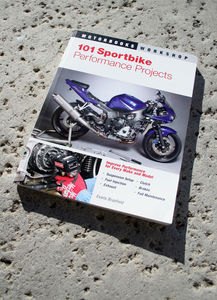Book Review: Sportbike DIY
Book Review: 101 Sportbike Performance Projects by Evans Brasfield
Illustrated. 256 pps. Motorbooks International. $29.95
"@%$#!"
That's the sound you've made a hundred times, right after you've skinned your knuckles, broken something expensive, dropped something tiny in a dark place, or realized you spent the last two hours doing something wrong, and now you'll have to do it all over again, and you need to ride your motorcycle to work in an hour. Ironically, that word rhymes with "duck." Even if you don't have a Ducati.
Maybe it's the fault of the silly photocopied instructions we get with our beautiful and expensive aftermarket accessories. You know the ones. They have blurry, photocopied illustrations and vague text that reads like it was lifted out of the computer game "Myst." Or maybe it's those factory shop manuals, written for mechanics that are as comfortable adjusting shim-under-bucket valve trains as you are adjusting your underwear. ("Engine Removal. Step One: Remove Engine. Step Two: Reverse Step One.")
Don't you wish somebody would write a comprehensive book with clear instructions on how to do the tasks we ordinary sportbikers tackle everyday in our garage?
Well, Evans Brasfield, a motojournalist and freelance writer, has come to the rescue with his book, 101 Sportbike Performance Projects. In this book, Evans has taken 101 of the most common tasks a home mechanic might attempt on his sportbike and written a clear guide, with great illustrations and clear text, about how to perform those tasks with a minimum of frustration and heartbreak.
The book is divided into 101 small one- to three page articles. They are arranged by category and are coded to tell the reader how difficult, time consuming and expensive they are. Also, there is a scale to let you know how beneficial this modification or task will be.
Basic maintenance is the first section, as Brasfield wants the reader to make sure his bike is well-maintained before they start changing things. He starts with the basic pre-ride check and works his way through the basic things most manufacturers call for in a "level I" or minor service, like an oil change, coolant flush, chain adjustment, cable adjustment, spark plug change and re-tourquing of all fasteners. All these things can be performed with basic tools, and Brasfield tells us the little tricks a professional mechanic uses for speed and precision, like using the string method for aligning your rear axle.
Basic maintenance? Isn't this a "performance" guide? Brasfield's point is clear: an ill-tuned bike is going to be a pig, no matter what you bolt onto it, and you have to learn how to wrench on your bike by doing basic maintenance tasks before you can do the more complex tasks, like modifications, safely and competently. It's a good lesson, one that many websites and magazines gloss over. A well-tuned stock 600cc sportbike will probably be much faster than a clapped-out R1.
The next few sections go over all the systems your sportbike has, including brakes, wheels and tires, suspension, chassis, electrical system, fuel system and engine/transmission. Jobs range from the mundane and simple, like selecting the best tires, to a complete engine rebuild. Brasfield is a patient and thorough teacher, who seems to have an uncanny feel for what amateur mechanics go through trying to modify their motorcycles in their poorly-lit, cramped garages.
For example, Evans has a section on installing a handlebar kit on a sportbike, just like I did last year on my Triumph Speed Four. I always have a hard time figuring out where to drill the little holes for the pins on the switchpods. As it turns out, not only do those pegs have a special name ("registration pins"), but there is a very good method for placing the holes, marking them, and drilling them in a neat-looking, professional manner. My switchpods, on the other hand, are angled funny, as I did not have access to this book when I attempted my installation.
Brasfield bridges the gap neatly between the hyper-technical shop manual and the scanty directions you get when you purchase an aftermarket part. When you get a set of aftermarket brake rotors, they rarely come with instructions telling you to do things like heating the old bolts before trying to loosen them, or using a tire under the wheel to avoid damaging your new disc when bolting its twin to the other side. Have I snapped the heads off of the stuck disc bolts on my KLR? Oh yes.
After all the go-fast goodies have been installed, Evans anticipates the inevitable with a final section about crash repair. He shows us the best way to repair broken fiberglass and plastic bodywork, and also how to install aftermarket bodywork to save money. I've never heard of a method for cutting bodywork to install frame sliders other than trial and error, but Brasfield includes one here, with his usual excellent photography and step-by-step instructions.
Obviously, 101 Sportbike Performance Projects isn't a shop manual for every kind of sportbike ever made, and I don't think it was intended as one. Instead, it is a supplement to shop manuals, intended to gently guide the novice and intermediate home mechanic through repairs and mechanical jobs that seem overwhelmingly complex and difficult. As such, this book definitely succeeds. It is comprehensive, slickly produced, fun to read and very nicely illustrated. It's earned a spot in my garage and is well worth the asking price, unless you like your switchpods at a funny angle.
More by Gabe Ets-Hokin

































Comments
Join the conversation